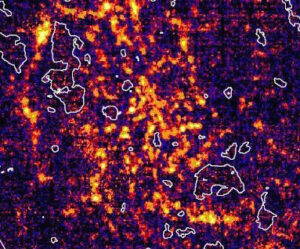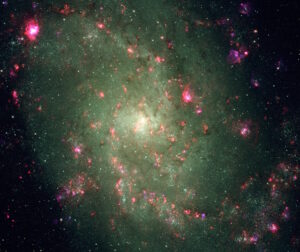MESSIER 33
The IRAM M33 Survey is a Large Program designed to map the nearby galaxy Messier 33 with the multibeam receiver HERA at the IRAM 30m telescope in the CO(2-1) line transition. Full coverage is obtained out to a radius of 7 kpc.
The goal of the M33 survey was to generate a sensitive data set which allows to identify all molecular gas traceable by the CO molecule much beyond the limit of existing maps. This data set allows to investigate molecular cloud and star formation in a low metallicity environment on the scale of individual GMCs. The IRAM data set matches a large number of high quality data sets with comparable spatial resolutions (HI, NIR, Halpha and in particular the FIR data sets stemming from the Herschel program HERM33ES).

The inner 5 kpc of M33: CO(2-1) intensity map © IRAM/Druard

The inner 5 kpc of M33 : Optical image © KPNO/NOAO/NSF/Nichole King
As part of the M33 CO Large Program, the CO(2-1) line has been observed over the whole disk down to a noise level of 20mK/channel. The data are at a spatial resolution of 12″ and a spectral resolution of 2.6km/s. The On-The-Fly mapping technique was used with the HERA multibeam dual-polarization receiver on the IRAM 30meter telescope on Pico Veleta (Spain). The backend was the WILMA broad-band auto-correlator.
The M33 CO(2-1) survey repository is located at IRAM.
Please refer to Gratier et al (2010, A&A 522, 3) and Druard et al (2014, A&A 567, 118) whenever these data are used in a publication.
The two most important data products are a cube, with line intensity in Kelvin on the Ta* scale for each velocity at each spatial pixel, and a map of the integrated intensity, in Kelvin (Ta* scale) km/s. The observing strategy and data reduction are described in Gratier et al (2010, A&A 522, 3) and Druard et al (2014, A&A 567, 118). An important aspect is the use of the low-noise HI line data to fit baselines and define the windows over which the CO is integrated to obtain the integrated intensity map. The total field of view is large – a discussion of the error beam pickup can be found in Druard et al. (2014, A&A 567, 118) and in the PhD thesis by Druard (2014).
Last updated : Feb 18, 2016

